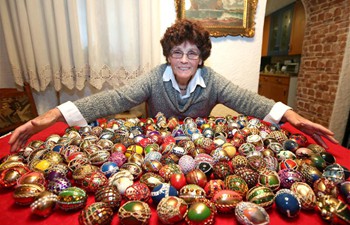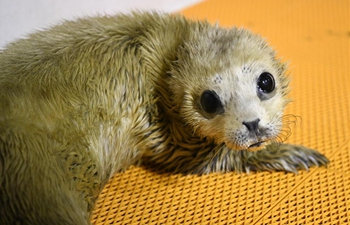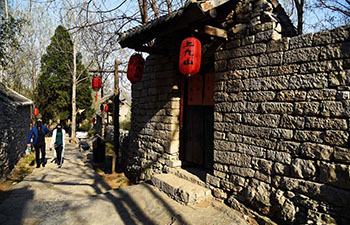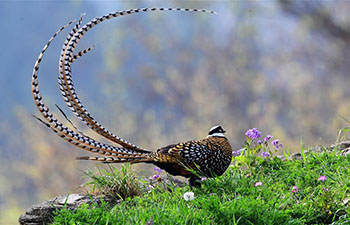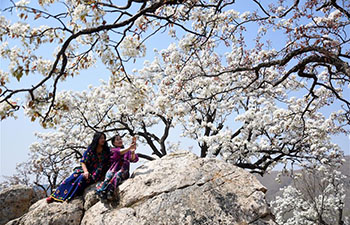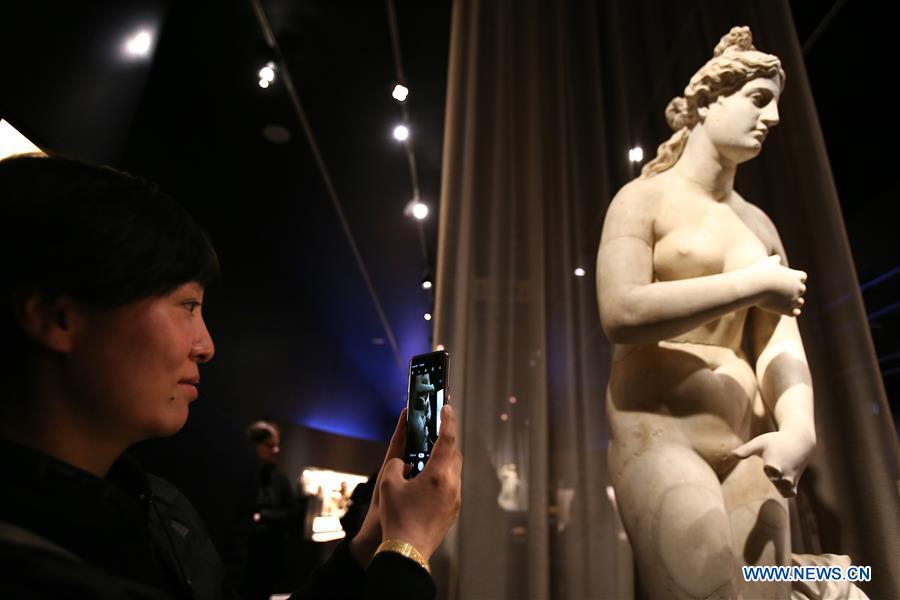
A visitor takes photos of a Roman statue of Greek goddess Aphrodite, which is displayed for the first time at the exhibition "The Countless Aspects of Beauty" held by the National Archaeological Museum, in Athens, Greece, April 4, 2019. A marble statue of the Greek ancient goddess Aphrodite along with two scents from antiquity were unveiled at the National Archaeological Museum of Greece on Thursday to mark one-year anniversary of the temporary exhibition "The countless aspects of Beauty." (Xinhua/Marios Lolos)
by Alexia Vlachou
ATHENS, April 5 (Xinhua) -- A marble statue of the Greek ancient goddess Aphrodite along with two scents from antiquity were unveiled at the National Archaeological Museum of Greece on Thursday to mark one-year anniversary of the temporary exhibition "The countless aspects of Beauty."
Since the opening of the exhibition in May 2018, more than 430,000 visitors from all around the world had passed through its doors and enjoyed artifacts from the Neolithic period to late antiquity illustrating the timeless desire of humans for the beautiful.
A year after its huge success, the exhibition continues to be on the spotlight with the new additions.
"Our visitors have the opportunity to admire this naked Aphrodite which comes in this space to smell two new scents from antiquity," Maria Lagogianni, director of the National Archaeological Museum, told Xinhua.
After being restored, Aphrodite statue emerged from the storerooms of the Museum for the first time to light up the space and delight visitors with its charm.
Once belonging to the Greek leading art dealer Alexandros Lolas, the statue entered the museum collections in 1988.
It is a distant descendant of the first monumental female nude in classical sculpture, the Aphrodite of Cnidus by Praxiteles, a Greek renowned sculptor, as Lagogianni pointed out.
The sculpture of the most renowned sculptor of the 4th century BC was destroyed. But many Roman copies survived his influential work of art.
Its style is based on a Hellenistic version of the Aphrodite of Praxiteles, attributed to his son, Cephisodotus.
The goddess which belongs to the Capitolian type is recognizable from the position of the arms. Standing after a bath and depicted totally naked, Aphrodite covers prudishly her breasts and genitals with her hands.
According to the archaeologists, its case is unique as it depicts an artefact that is consisted of fragments from different periods of times.
The head and the body were from the Roman times, while the rest of the body parts were subsequent restorations with different marbles later in an attempt to form a statue that resembled to the Cnidian Aphrodite of Praxiteteles.
According to Lagogianni, it is a practice introduced during the Renaissance when the classical antiquity was rediscovered.
Artists, sculptors and craftsmen of the Renaissance drew inspiration directly from works of antiquity and restored the destroyed pieces to decorate the houses and courtyards of patrons and collectors at that times.
The most challenging part for the museum's team was the conservation of the unknown Aphrodite to monitor its previous condition by implementing new methods and technologies. They used ultraviolet lighting and digital microscopes to examine the materials and to classify the marbles. They also used radiography to inspect the internal metal structure conservators, according to the museum officials.
After long cleaning and conservation works, Aphrodite has taken its place next to the other treasures of antiquities to reveal her beauty secrets, among which is the world of fragrance.
The world of fragrance takes a distinct place in antiquity. Closely linked to the Greek ancient goddess Aphrodite, perfumes and scented oils are mentioned in ancient myths as an indispensable accessory for gods and mortals when preparing for special appearances.
"Our cooperation with the National Archaeological Museum is our most proud moment as Greeks and scientists," Lena Korres, co-founder of Korres, the cosmetics brand which produced the scents, told Xinhua, adding that they created the two scents based on archeology researches to follow the production methods of ancient fragrances.


